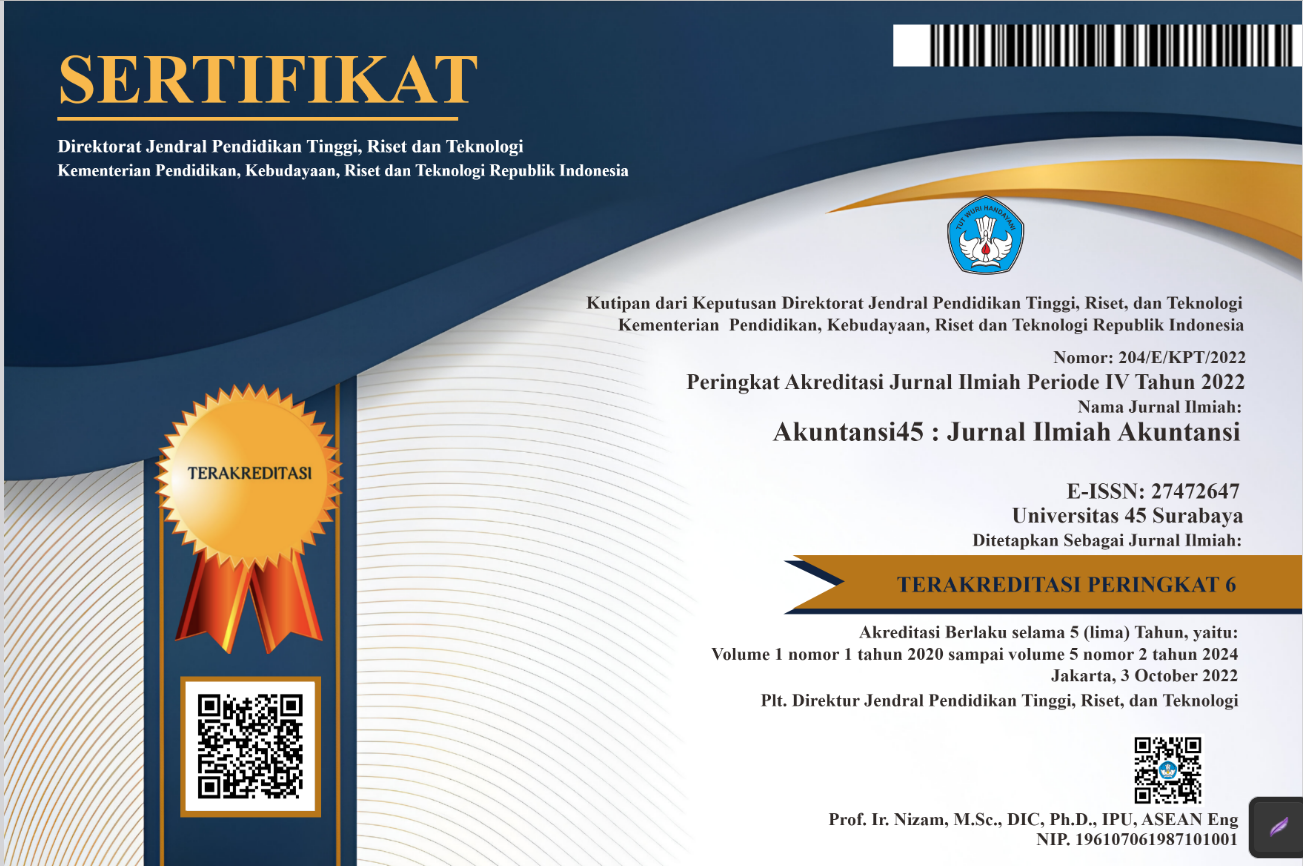Pengaruh Sukuk Bank Indonesia Dan Bi Rate Terhadap Inflasi di Indonesia Periode 2020-2023
DOI:
https://doi.org/10.30640/akuntansi45.v6i1.4394Keywords:
Inflation, Bank Indonesia Sukuk, Interest RateAbstract
This study aims to determine the Effect of Company Growth and Operational Complexity on Auditor Switching Mediated by Audit Delay. The data used are secondary data taken from audited financial statements in 2021-2023. Sample selection was carried out using the purposive sampling method and the number of samples that met the criteria was 10 companies with 30 observations. This research method is a quantitative method. The hypothesis testing of this study uses logistic regression analysis and path analysis assisted by the Statistical Program for Special Science (SPSS) version 25. The results of this study indicate that partially company growth does not affect audit delay, operational complexity affects audit delay, company growth does not affect auditor switching, operational complexity affects auditor switching and audit delay does not affect auditor switching, Company growth through audit delay has an effect on auditor switching, and operational complexity through audit delay has an effect on auditor switching.
References
Akal, A. Y. (2023). Inflation and Reinforced Concrete Materials: An Investigation of Economic and Environmental Effects. Sustainability, 15(9), 7687. https://doi.org/10.3390/su15097687
Ali, M., Naqi, S. M. A., & Habib, M. (2023). The study “Unravelling the Impact: Assessing the Impacts of Rising Rates of Interest and Inflation on Individual Finances.” Sjesr, 6(2), 56–62. https://doi.org/10.36902/sjesr-vol6-iss2-2023(56-62)
Angelina, S., & Nugraha, N. M. (2020). Effects of Monetary Policy on Inflation and National Economy Based on Analysis of Bank Indonesia Annual Report. Technium Social Sciences Journal, 10, 423–435. https://doi.org/10.47577/tssj.v10i1.1300
Apriliani, D. (2022). Analisis Pengaruh Variabel Makroekonomi Terhadap Inflasi Di Indonesia. Ekopem: Jurnal Ekonomi Pembangunan, 4(4), 106–119. https://doi.org/10.32938/jep.v4i4.3113
Atigala, P., Maduwanthi, T., Gunathilake, V., Sathsarani, S., & Jayathilaka, R. (2022). Driving the pulse of the economy or the dilution effect: Inflation impacting economic growth. PLOS ONE, 17(8), e0273379. https://doi.org/10.1371/journal.pone.0273379
Baltensperger, E. (2023). The return of inflation. Swiss Journal of Economics and Statistics, 159(1). https://doi.org/10.1186/s41937-023-00114-x
Bergin, P. R., & Corsetti, G. (2020). Beyond Competitive Devaluations: The Monetary Dimensions of Comparative Advantage. American Economic Journal: Macroeconomics, 12(4), 246–286. https://doi.org/10.1257/mac.20160094
Botos, K. (2022). Mit tanulhat az utókor Irving Fishertől? Hitelintézeti Szemle, 21(2), 175–187. https://doi.org/10.25201/hsz.21.2.175
Crespo, A. C., Solanes, J. G., & Flores, F. T. (2022). External competition flattens the Phillips Curve. Revista de Economía Mundial, 60, 295–327. https://doi.org/10.33776/rem.v0i60.4962
Damayanti, S. A., & Jalunggono, G. (2022). Analysis Of The Influence Of Macroeconomic Variables On Inflation: The Vecm Approach. Journal Of Humanities, Social Sciences And Business (JHSSB), 2(1), 199–218. https://doi.org/10.55047/jhssb.v2i1.402
Eo, Y., & Morley, J. (2020). Why Has the U.S. Economy Stagnated Since the Great Recession? The Review of Economics and Statistics, 104(2), 1–46. https://doi.org/10.1162/rest_a_00957
Faruqi, A., Ariani, M. B. N., & Nofrian, F. (2022). BI Rate The FED Rate dan Inflasi Terhadap Indeks Harga Saham Gabungan. Jurnal Indonesia Sosial Sains, 3(5), 877–889. https://doi.org/10.36418/jiss.v3i5.588
Fauzi, F., & Suhaidi, M. (2023). Effect of Bank Indonesia Sharia Certificate and Inflation on Islamic Interbank Money Market Transactions in Indonesia. Asian Journal of Engineering, Social and Health, 2(2), 146–160. https://doi.org/10.46799/ajesh.v2i2.40
Fitriyani, E., Iranto, D., & Dianta, K. (2023). Pengaruh Jalur Transmisi Kebijakan Moneter terhadap Inflasi di Indonesia. Jurnal Perspektif, 21(1), 60–68. https://doi.org/10.31294/jp.v21i1.15193
Girdzijauskas, S., Streimikiene, D., Griesiene, I., Mikalauskiene, A., & Kyriakopoulos, G. L. (2022). New Approach to Inflation Phenomena to Ensure Sustainable Economic Growth. Sustainability, 14(1), 518. https://doi.org/10.3390/su14010518
Greenwood, R., Hanson, S., & Vayanos, D. (2024). Supply and Demand and the Term Structure of Interest Rates. Annual Review of Financial Economics. https://doi.org/10.1146/annurev-financial-082123-110048
Immanuel, D., & Yayamo, E. (2020). Monetary Economics Overview Includes Monetary Policy Instruments, Functions and Impacts. Journal Dimensie Management and Public Sector, 1(2), 20–26. https://doi.org/10.48173/jdmps.v1i2.50
Khuzaimah, I., & Fauzi, H. (2022). Kebijakan Moneter Dan Tingkat Inflasi Pada Era New Normal Di Indonesia. Al-Qashdu Jurnal Ekonomi Dan Keuangan Syariah, 2(2), 85–85. https://doi.org/10.46339/al-qashdu.v2i2.751
López, S. F., Álvarez‐Espiño, M., Rey‐Ares, L., & Castro‐González, S. (2023). Consumer financial vulnerability: Review, synthesis, and future research agenda. Journal of Economic Surveys. https://doi.org/10.1111/joes.12573
Malenković, N. (2022). The effect of the inflation rate on gross domestic product: An economic analysis for the Western Balkans countries. Strategic Management, 00, 28–28. https://doi.org/10.5937/straman2200026m
Mayasari, F., & Mahinshapuri, Y. F. (2022). Pengaruh Inflasi Terhadap Pertumbuhan Ekonomi Di Indonesia. JEB17 Jurnal Ekonomi Dan Bisnis, 7(02), 119–132. https://doi.org/10.30996/jeb17.v7i02.7362
Melaku, E. W. (2020). Determinants of Inflation in Africa: A Systematic Review. International Journal of Management and Fuzzy Systems, 6(4), 59. https://doi.org/10.11648/j.ijmfs.20200604.11
Muhayatsyah, A. (2020a). Aspek Syariah Pada Instrumen Sukuk: Analisis Penerapan Sukuk Wakaf Di Indonesia. J-ISCAN: Journal of Islamic Accounting Research, 2(2), 67–91. https://doi.org/10.52490/j-iscan.v2i2.891
Muhayatsyah, A. (2020b). Aspek Syariah Pada Instrumen Sukuk: Analisis Penerapan Sukuk Wakaf Di Indonesia. J-ISCAN: Journal of Islamic Accounting Research, 2(2), 67–91. https://doi.org/10.52490/j-iscan.v2i2.891
Murtiningrum, W. (2023). Effect of the BI Rate, Inflation and Exchange Rates on Consumer Goods Stock Prices. Adpebi International Journal of Multidisciplinary Sciences, 2(1), 72–79. https://doi.org/10.54099/aijms.v2i1.468
Nurfitriani, Rizaldi, M., & Tanyong, A-aeso. (2022). Effect of Inflation and BI Rate on Murabahah Financing in PT. Bank Syariah Indonesia. JEKSYAH (Islamic Economics Journal), 2(02), 90–101. https://doi.org/10.54045/jeksyah.v2i02.76
PĂTRUŢI, A. (2023). Keynes and Hayek: some common elements in business cycle theory. Brazilian Journal of Political Economy, 43(1), 48–66. https://doi.org/10.1590/0101-31572023-3375
Rahayu, R. M. P., & Hutajulu, D. M. (2023). Peranan Ihsg, Suku Bunga, Dan Kurs Rupiah Dalam Mempengaruhi Pergerakan Inflasi Di Indonesia. Prima Ekonomika, 14(1), 1. https://doi.org/10.37330/prima.v14i1.144
Romaisyah, L., Aini, S. N., & Agustin, R. (2023). Analisis Dominasi Akad Ijarah Dalam Obligasi Syariah Di Indonesia. Competence Journal of Management Studies, 17(1), 29–39. https://doi.org/10.21107/kompetensi.v17i1.19082
Santos, J. de F., & Lages, A. M. G. (2020). Teorias Sobre Inflação: Uma Breve Resenha Descritiva e Didática da Literatura. Uma Introdução ao Tema. Nexos Econômicos, 14(2), 94–110. https://doi.org/10.9771/rene.v14i2.42023
Saputra, I. M. (2024). Monetary Policy and Inflation Targeting Framework in Indonesia Dual Banking System. Islamic Capital Market, 1(1). https://doi.org/10.58968/icm.v1i1.445
Sari, S. P., & Nurjannah, S. (2023). Analisis Pengaruh Nilai Tukar, Jumlah Uang Beredar dan BI Rate Terhadap Inflasi di Indonesia dan Dampaknya Terhadap Daya Beli Masyarakat. Aktiva, 1(1), 21–29. https://doi.org/10.24260/aktiva.v1i1.1015
Sari, Y., Herlin, F., & Havilla, S. (2024). Pengaruh Suku Bunga BI Rate dan BI 7 Day Reverse Repo Rate terhadap Inflasi di Indonesia dengan Metode Vector Autoregression (VAR). EKONOMIS Journal of Economics and Business, 8(1), 754–754. https://doi.org/10.33087/ekonomis.v8i1.1711
Simanungkalit, E. F. B. (2020). Pengaruh Inflasi Terhadap Pertumbuhan Ekonomi Di Indonesia. Journal of Management : Small and Medium Enterprises (SMEs), 13(3), 327–340. https://doi.org/10.35508/jom.v13i3.3311
Siska, W. (2022). Analysis of the Risk and Return of Bonds and Sukuk Listed on the Indonesia Stock Exchange. Modern Economics, 33(1), 99–109. https://doi.org/10.31521/modecon.v33(2022)-13
Suar, A., Zain, Z. P., & Hijrasil. (2022a). Sharia Monetary Policy Instruments in Indonesia. JOVISHE : Journal of Visionary Sharia Economy, 1(1), 01-11. https://doi.org/10.57255/jovishe.v1i1.63
Suar, A., Zain, Z. P., & Hijrasil. (2022b). Sharia Monetary Policy Instruments in Indonesia. JOVISHE : Journal of Visionary Sharia Economy, 1(1), 01-11. https://doi.org/10.57255/jovishe.v1i1.63
Suginam, S., Afriany, J., Sianturi, M., & Rahayu, S. (2022). Pengaruh Inflasi Terhadap Minat Beli Konsumen Terhadap Produk. Ekonomi, Keuangan, Investasi Dan Syariah (EKUITAS), 4(2), 436–441. https://doi.org/10.47065/ekuitas.v4i2.2395
Triastuti, D., Winarti, E., & Taufiq, M. (2023). Pengaruh Kurs, Deposito Dan Bi Rate Terhadap Profiatbilitas Dengan Kredit Sebagai Variabel Mediasi ( Studi Empiris Pada Bank Umum Di Indonesia ). Jurnal Kendali Akuntansi, 1(2), 112–141. https://doi.org/10.59581/jka-widyakarya.v1i2.235
Winarto, F. H., & Beik, I. S. (2024a). The effect of Sharia monetary policy instruments and Islamic bank financing on economic growth and inflation. Jurnal Ekonomi & Keuangan Islam, 72–89. https://doi.org/10.20885/jeki.vol10.iss1.art6
Winarto, F. H., & Beik, I. S. (2024b). The effect of Sharia monetary policy instruments and Islamic bank financing on economic growth and inflation. Jurnal Ekonomi & Keuangan Islam, 72–89. https://doi.org/10.20885/jeki.vol10.iss1.art6
Downloads
Published
How to Cite
Issue
Section
License
Copyright (c) 2025 AKUNTANSI 45

This work is licensed under a Creative Commons Attribution-ShareAlike 4.0 International License.









